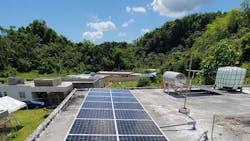Delaying the Energy Transition: DER, Microgrid Developers Forced to Wait for Transformers, Interconnection, IRA Clarification
Distributed energy resource (DER) and microgrid developers are grappling with long utility interconnection queues and transformer shortages, which are slowing their projects and increasing costs.
In addition, nonprofit organizations are waiting for clarification about provisions of the Inflation Reduction Act (IRA) that could lower their costs. But they say that holding out for clarification can boost their project expenditures.
These challenges are slowing the transition to clean energy – and should be addressed with new policies, workforce development and education, industry members say.
“I’ve seen reports that interconnection can take many, many years,” said Woody Hastings, program manager for The Climate Center. “Beyond a couple of months, people want these things interconnected when they’re ready to be connected. It’s ludicrous to talk about a year to 10-year wait.”
Two California bills aim to address interconnection delays
In California, two bills, AB 50 and SB 410, recently signed by Gov. Gavin Newsom, are expected to provide some interconnection relief. AB 50 requires utilities to report to the California Public Utilities Commission (CPUC) and identify the criteria for providing timely interconnection services. AB 50 also institutes reporting requirements for investor-owned utilities about how and why delays are occurring.
Under AB 50, the CPUC will analyze the reasons for delays and develop a set of resolutions for how utilities should address the delays, Hastings said.
SB 410 requires the CPUC to decrease the time for utility connection and upgraded service. It also calls for shorter target interconnection times and sets a target timeline for utilities to connect different types of resources.
“If we’re going to reach our climate goals in California, we need distribution system operation that expedites interconnection,” Hastings said.
Labor shortages creating transformer challenges
Long wait times for transformers are also slowing progress on microgrids and DERs, said Astrid Atkinson, CEO and co-founder of Camus Energy, which provides grid orchestration and management software. Camus Energy works with a number of utility cooperatives, and some are struggling to acquire transformers for microgrids and DERs.
Labor shortages are the main culprit behind the transformer wait times, said Peter Ferrell, director of government relations for the National Electrical Manufacturers Association (NEMA), which is working to address the shortages. The transformers are often handmade products whose production can’t be automated, he said. The clean energy tax credits in the IRA have significantly boosted the number of DER projects, and, along with them, the need for transformers.
“Distribution transformers are needed for everything, which creates part of the issue. You can’t turn on a light switch without it going through a transformer,” Ferrell said. “You can’t add solar without transformers. They will always be in demand.”
Atkinson is now working with a few utilities that have solar, storage and microgrid development projects in their territories that are getting hung up by transformer shortages. One utility had to wait six months to get a transformer, then had to send it back for repairs three times because it arrived leaking. That led to a one-year delay deploying the microgrid, which hurt the economics of the project.
Project economics are undermined by delays
“The economics of any project like that are always based on the availability of products at a certain time. If the project is not working correctly, it isn’t paying back investments. Delays damage the economics for customers, utilities and installers,” Atkinson said.
DER and microgrid developers are most in need of medium-voltage transformers, she noted.
“The majority of community-scale solar and storage projects – what utilities work with mostly – are seeing some sort of construction delay due to the availability of transformers,” she said.
Developers are seeing low-voltage transformers delayed for 1.5 years to two years. Some of the higher voltage transformers are running up to five years late. Such delays slow the deployment of community solar programs, electric vehicle charging infrastructure, microgrids and other DERs, Atkinson said.
DOE plan could exacerbate transformer shortages
To help solve the problem, NEMA hopes to convince the federal Department of Energy (DOE) to step away from a proposed rule to ensure transformers are more efficient.
“If the DOE rulemaking goes into effect, all transformers would have to be made with amorphous steel instead of electrical steel. Our manufacturers can’t source or develop supply chains on the scale they’re needed,” said Ferrell. “Our biggest fear: Shifting that supply chain would add even more time to the lead time issue.” In fact, the rule would add six to 12 months or more to lead times for transformers, he said.
NEMA suggests shelving the proposed efficiency standards, letting the market crank out as many transformers as possible and launching workforce development efforts, including immigration waivers and the creation of more technical schools, said Ferrell.
“We need resources to attract folks to this line of work,” he said.
An energy equity project developer wants more IRA certainty
Meanwhile, nonprofit organizations that are trying to deploy energy equity projects are seeking clarification about the benefits they’ll receive under the IRA.
The IRA increased the size of investment tax credits (ITC) available for green energy projects with a social mission by 10% to 20%, and it also created ITC direct pay options for nonprofits that don’t pay taxes, said Lauren Rosenblatt, Barrio Electrico’s founder and CEO. Her company, a nonprofit, installs clean energy systems in Puerto Rico.
Such projects include residential systems for low- and moderate-income communities and community solar projects for disadvantaged communities – the types of projects Barrio Electrico deploys in Puerto Rico. The projects tend to be smaller systems connected to homes, buildings or the distributed grid. Smaller systems are more expensive per installed kilowatt and need the 10% to 20% bonus ITC credits available under the IRA for developing clean energy projects in disadvantaged communities to make the projects viable, she said.
When the IRA was first passed, the energy industry celebrated the expansion of the ITC to support energy equity projects.
One company’s IRA paradox
“Barrio Eléctrico has been working on energy justice with a mission of resilient energy for Puerto Ricans since long before the IRA, and we were excited about these changes to the ITC. We now find ourselves in an IRA paradox,” said Rosenblatt.
Smaller project developers have always had a hard time taking advantage of the ITC because the legal and insurance costs surrounding a tax equity investment tend to be large and undermine the economics of smaller projects.
But capturing the IRA’s new bonus credits and direct pay isn’t easy, Rosenblatt said. It’s not as straightforward as claiming the baseline 30% ITC for green energy, she explained. “The bonus credits are limited by a total of 1.7 GW of projects for 2023 projects and 1.7 GW of projects for 2024 projects. Projects must apply and hope they receive an allocation of that total capacity,” she said.
In addition, more than a year after the IRA passed, the rules and procedures are unclear, and the application process is complex. As a result of this complexity, investors want to wait until they know how to capture the IRA benefits.
Like the project developers held back by interconnection and transformer hang-ups, the nonprofits aiming to create energy equity are waiting – and waiting.
“Those of us who are working on mission-driven projects find these challenges not only disheartening but puzzling,” Rosenblatt said. “The result is a throttling of funds just as these projects are gaining momentum.”
Track news from all phases of the microgrid project pipeline. Subscribe to the free Microgrid Knowledge Newsletter.








